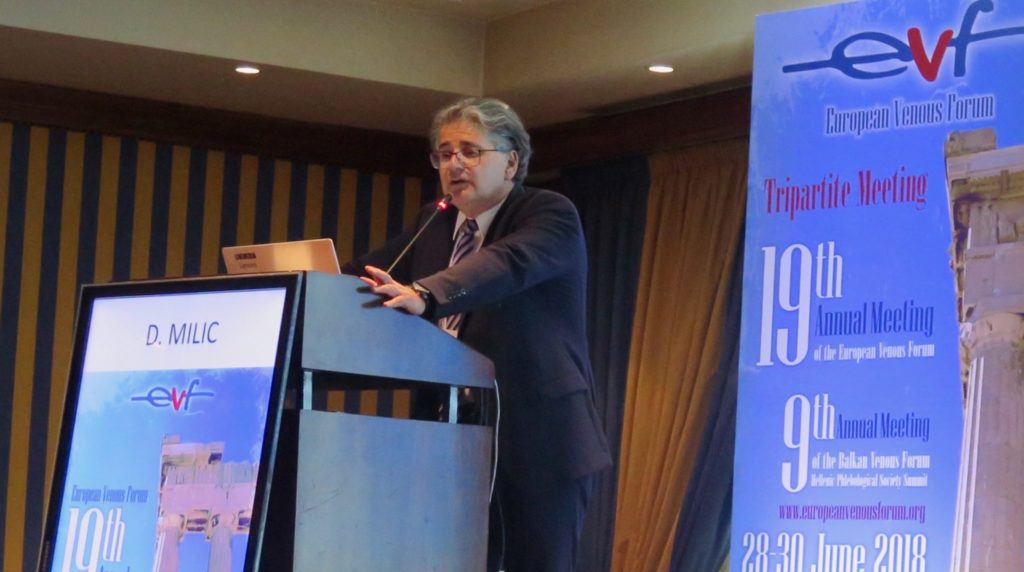
A new randomised controlled trial evaluated the preventative effect of compression stockings during pregnancy on the incidence of varicose veins as well as venous thromboembolism, with results suggesting that women with no venous disease using compression stocking during pregnancy were up to three times less likely to develop varicose veins. The results were presented by Dragan Milic (Clinical centre of Nis, Nis, Serbia) at the European Venous Forum (EVF; 28–30 June, Athens, Greece).
“Varicose veins develop in 8–20% of pregnant women,” Milic stated at the EVF meeting, noting that pregnancy increases the risk of venous thromboembolism (VTE) four- to five-fold as compared to the nonpregnant state. For varicose veins, risks increase with each pregnancy, developing in 13% of primiparous women, 30% of secundiparous women, and reaching up to 57% in multiparous women. Milic explained that varicose vein risk factors related to pregnancy include increased blood volume, high progesterone levels “allowing veins to stretch more than the normal state,” and “pressure exerted on the pelvic veins by the enlarging uterus, which causes obstruction of the flow of venous blood out of the legs.” The effects of pregnancy can result in sustained high pressure in the veins, causing them to stretch.
The study by Milic et al randomised 146 participants into three arms: group A (n=46), which prescribed Class 1 thigh-high elastic stockings with a compression of 17–20mmHg; group B (n=49) which prescribed Class 2 thigh-high elastic stockings with a compression of 20–25mmHg; and group C (n=51), a control group which received no compression therapy. Participants were a mean age of 25 years, in fetal gestation between 6–10 weeks at enrolment, with healthy veins. This was defined as “no visible or palpable signs of venous disease, no previous history of venous disorders and normal duplex scan vein examination.”
Participants receiving compression therapy were instructed to wear compression stockings during the day, worn daily until time of delivery. One pair of stockings were provided per participant, and changed after four months. Main outcomes were incidence of varicose veins, superficial thrombophlebitis and deep venous thrombosis.
Only one patient, enrolled in the control group, presented with thrombophlebitis. The study was therefore unable to observe any statistically significant differences or make any powered comparison for this outcome. Varicose veins, meanwhile, were developed in 14 patients of the control group (27.46%) vs. five in group A (14.28%) and three in group B (8.82%). This statistically significant difference between the arms led Milic to conclude that “the results obtained in this study suggest that compressions hosiery may reduce by two- to three-fold the incidence of varicose veins in pregnant women.”
However, of the initial 146 enrolled participants, only 121 completed the trial. “Drop-out rate was really high due to non-compliance,” Milic explained, with 11 participants in group A (23.91%) and 15 in group B (30.61%) unable or unwilling to wear the compression stockings for more than 50% of the time throughout the study period, or were without compression for more than seven consecutive days. “I think the biggest problem in compression therapy is non-compliance”, Milic noted, pointing to the prevalence of the problem in other compression therapy trials as well as in real-world data.
In the discussion following Milic’s presentation, Marianne De Maeseneer (Erasmus MC, Rotterdam, the Netherlands) questioned the choice of using thigh-high compression stockings in the study, as “several studies have shown there is no difference in prophylactic effect between below-the-knee and thigh-high compression stockings,” but importantly, below-the-knee length stockings are often considerably more bearable for daily use. For compression therapy patients and pregnant women in particular, De Maeseneer said, below-the-knee stockings are likely to be more bearable in terms of comfort and ease of use.













Hi is there a link to this study?